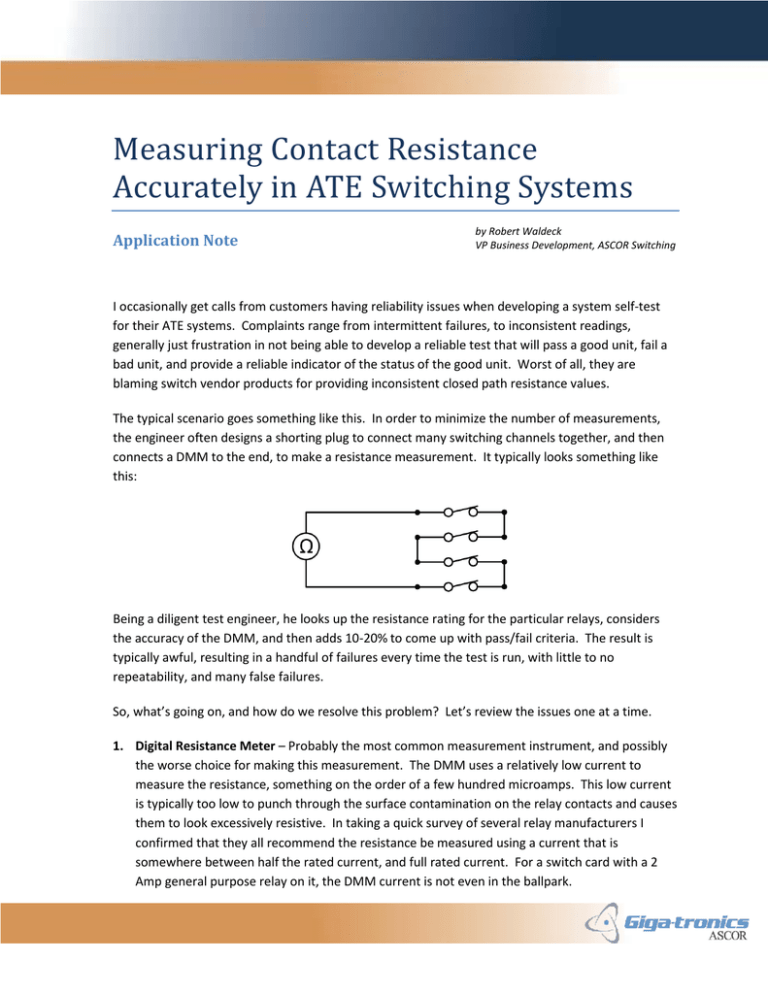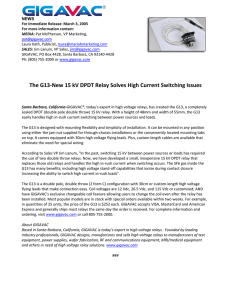
Measuring Contact Resistance
Accurately in ATE Switching Systems
Application Note
by Robert Waldeck
VP Business Development, ASCOR Switching
I occasionally get calls from customers having reliability issues when developing a system self-test
for their ATE systems. Complaints range from intermittent failures, to inconsistent readings,
generally just frustration in not being able to develop a reliable test that will pass a good unit, fail a
bad unit, and provide a reliable indicator of the status of the good unit. Worst of all, they are
blaming switch vendor products for providing inconsistent closed path resistance values.
The typical scenario goes something like this. In order to minimize the number of measurements,
the engineer often designs a shorting plug to connect many switching channels together, and then
connects a DMM to the end, to make a resistance measurement. It typically looks something like
this:
Being a diligent test engineer, he looks up the resistance rating for the particular relays, considers
the accuracy of the DMM, and then adds 10-20% to come up with pass/fail criteria. The result is
typically awful, resulting in a handful of failures every time the test is run, with little to no
repeatability, and many false failures.
So, what’s going on, and how do we resolve this problem? Let’s review the issues one at a time.
1. Digital Resistance Meter – Probably the most common measurement instrument, and possibly
the worse choice for making this measurement. The DMM uses a relatively low current to
measure the resistance, something on the order of a few hundred microamps. This low current
is typically too low to punch through the surface contamination on the relay contacts and causes
them to look excessively resistive. In taking a quick survey of several relay manufacturers I
confirmed that they all recommend the resistance be measured using a current that is
somewhere between half the rated current, and full rated current. For a switch card with a 2
Amp general purpose relay on it, the DMM current is not even in the ballpark.
2. Noise – ATE systems are extremely electrically noisy environments. Ground noise on the order
of tens of Millivolts is not unusual, along with artifacts of numerous clocks and 60 Hz elements.
Now imagine the shorting plug example we mentioned earlier. In order to reduce the number of
measurements, tens of channels are connected together in the shorting plug. Each of these
“shorts” connects together two lengths of wire, one from the switch card to the test interface,
and one to return to the switch card. 3 to 4 feet is not an uncommon cable length, so in the
case of 20 shorts, which is 40 round trips, we end up with over 100 feet of wire connected to
your low voltage, low current Resistance meter. How much noise do you think this 100 foot
antenna is going to pick up? Try switching the DMM to the millivolt range, and I think you would
be surprised.
3. Current – One common theme I have found with both electronic connector manufacturers and
relay manufacturers is that they are all measuring resistances below 1 ohm, and none of them
use a DMM to take the resistance measurement. One specific example recommends a test
circuit using 6 V and 1 Amp to take a voltage drop measurement. A test circuit is set up to
provide this voltage and current through the relay contacts, and the DMM is used “in voltage
mode” to measure the voltage drop across the relay contacts. The measurement looks
something like this for our example;
Resistance is then calculated. This is analogous to a 4-wire resistance measurement, but at much
higher voltage and current. I’m no metallurgist so I am not going to try to explain why this is the
case, but I’m confident there’s a good solid reason why they all do this.
4. Thermal Offset Error - ever use an electronic Thermocouple? They’re pretty simple devices, a
bi-metallic junction which generates an offset voltage, almost like a tiny battery. Heat up the
junction and the voltage increases. Very simple concept. The problem for us is that relays are
mechanically complicated devices and the manufacturers use a variety of different metals to
make up the various portions of the relays to provide the best performance of the relay. So
what does this mean to us? It means that there are a number of dissimilar metallic junctions
within the relays. Although these voltages are very tiny, maybe in the Microvolt range, they are
significant to our digital resistance meter which is using a few hundred microamps to measure
the resistance.
5. Contamination – Here’s a little known fact about relays. Part of the design of a relay is selecting
the proper contact materials such that they will self-clean in use. This means that a relay
AN-GT162A Measuring Contact Resistance Accurately in ATE Switching Systems
©Copyright 2013 Giga-tronics Incorporated. All rights reserved.
Page 2 of 4
designed to switch 30 VDC at 2 Amp actually depends on the tiny arc created by opening the
relay with this voltage and current across it to keep the contacts clean. Most ATE applications
are based on cold switching. We do this intentionally to extend the relay’s life. The unfortunate
side effect is that contamination will build up over time causing contact resistance to increase.
Solution
Now that we understand the error contributions, how do we resolve the problem? The simplest
answer is to follow the leaders, i.e. use a higher voltage and current to make the measurement. This
is a bit of a problem in ATE environments, and the suggestion above of using a 4-wire measurement
often isn’t practical and frankly provides a lot more accuracy than we are looking for. Remember,
the goal is to design a good reliable and repeatable test that will find bad relays and pass good ones.
Here, we are using a 6 V and 1 Amp test signal for testing our relays. If your relays have a higher
rating, you may need to modify the test. If the relays were truly at 0 Ω, the voltmeter will measure
the full 6 V from the source. If the relays were to have a combined resistance as high as 1 Ω, the
voltage would drop to 5.14 V, and your accurate DVM would detect this easily. 2 Ω yields 4.5 V and
so on. Here’s the math:
Let’s review the issues to see how this will help the situation.
1. Digital Resistance Meter – Using the voltage drop method uses the DMM’s voltmeter instead of
the resistance meter. The voltmeter is extremely accurate.
2. Noise – Using the voltage drop method increases the test current from hundreds of microamps
up to 1 Amp in the example above, it also increases the test voltage from microvolts up to 6 V.
This has the effect of making the tens of millivolts of noise insignificant to the measurement.
3. Current – As above, the voltage drop method increases the test current such that any noise
influence is insignificant.
AN-GT162A Measuring Contact Resistance Accurately in ATE Switching Systems
©Copyright 2013 Giga-tronics Incorporated. All rights reserved.
Page 3 of 4
4. Thermal Offset Error – As with the previous two examples, the voltage drop method increases
the voltage and test currents to a level which makes this error contribution insignificant.
5. Contamination – Now that you have redesigned the self-test to use the voltage drop method,
you have the perfect opportunity to design in a contact cleaning exercise. While the current is
applied, open and close the contacts a few times to perform “hot switching.” This will have the
beneficial effect of cleaning the contacts, and since it’s only run occasionally as part of self-test,
it should not shorten the life of the relays.
Conclusion
My hope is that you discovered this article before you designed your test system as it may not be an
insignificant task to change the measurement method over to the voltage drop method. If the test
is already designed, you are faced with two choices. Either redesign the wiring such that the voltage
drop method can be incorporated, or open the tolerances on the resistance measurements wide
enough to ensure consistent passing values (50 to 100 ohms) with the understanding that the test
has become more of a go/no-go test than a parametric measurement of the path resistance. Don’t
make the mistake of setting the tolerances based on the values you are measuring, the resistance
will surely creep up over time as the contamination builds up causing the test to become
intermittent and causing issues with a pile of false failures.
www.gigatronics.com
Phone / Email
Toll free: 800.726.4442 (USA)
+1 925.328.4650 (International)
Email: inquiries@gigatronics.com
AN-GT162A Measuring Contact Resistance Accurately in ATE Switching Systems
©Copyright 2013 Giga-tronics Incorporated. All rights reserved.
Page 4 of 4



